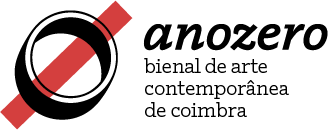O ruído dos sonhos [The noise of dreams]

At times in the evenings a face
Looks at us out of the depths of a mirror;
Art should be like that mirror
Which reveals to us our own face.
Jorge Luis Borges, “Ars Poetica” in Selected Poems 1923-1967, The Penguin Press (1972)
Looking at a simple stick half immersed in water, Ptolemy or Descartes and other wise men with a sharp eye are assailed by the strangeness of the sight. Stock-still outside-of-it the experience, they think it, crystalized in discursive artificiality. However, they do not throw themselves into it. They do not inhabit it. In doubt, they are-not-with-her-in-the-world[i], wrapped in tremor and amazement.
The issue is the mystery of vision, the imponderable dialectic of the visible. Curiosity without doubt is the mode of seeing woken by the exhibition O ruído dos sonhos [The noise of dreams], as it delivers to the realm of the sensible — like the dissimilarity of things in the world — the diversity of the works by Miguel Ângelo Rocha, Isabel Madureira Andrade, and Russell Floersch.
Socrates says: the eye drags the body as it tries to escape the cavern, the dungeon of vision where shadows and echoes are jailers, towards the light that reveals the immaterial and immutable Forms. [ii] However, it omits the vision that takes place in the movement of the body. The noise of dreams is a manifestation of Forms alien to metaphysics, without idealism or intangibility.
Faced with these Forms, vision happens without tautology in the thickness of a web of relationships that is weaved between work, space, and body. This web opens a fold; it tears the retinal presence and releases the latency of the invisible. When the mind deposits in the imagination an excess that emanates from the work but is not there, this excess becomes an extension of the body, an incarnate supplement, their own flesh. [iii] Being-with these Forms, to inhabit according to a principle of negativity, is the dialectic of dismantling the sensible, thought, the self that sees, and sees itself, of raising the overdetermined, incessant recreation. [iv]
Paintings, sculptures, buildings, objects. Potency and dynamics, eye and hand. Spasms in expansion and contraction, intuition and decision. Proposals without illusion or representation, without autonomy or specificity. They are the fall into the open chasm, the surrendering to the incident. Delusion without fiction.
The question is not what happens; it is, rather, that something happens. A bewilderment. A tremor, a shock, a disturbance. Something unknowable, unspeakable, inexpressible, irrepresentable. An elevation to the threshold where collide and coexist anguish — the deprivation of any rhetoric and poetics referring to what happens — and voluptuousness — relief from some uncertain and ambiguous future, the flame of the possibilities of meaning, recognizable only in the event. [v]
The something that happens is performance, an happening. Phenomenon of the body in action, semantic disturbance without rehearsal or script; the unrepeatable [vi] — fatal paradox of the in-actual. Contingent and precarious, a now as temporal ecstasy. It is dys-chronic, anachronism of the extemporaneous contemporary, mismatch of the now-not-yet. [vii] It is a constellation of nows in permanent reconfiguration. In a time that is as “too original” as “too new”, the outdated struggles with the linear progression of time. [viii] The heterochronic constructs a counter-space, an opaque mirror. An out-of-space, existing and locatable outside, but that neutralizes and recreates it, a heterotopia of visible spectra. [ix]
Being-with in any time and place; a certain inadequacy in the eye’s adherence to external light — a cosmogenesis, a company of alterities, simultaneities and promiscuities. The threshold of the between, The noise of dreams is the thin membrane where ‘the sensible’ and ‘the being’ separate.
Ricardo Escarduça
[1] Expression adapted from the term enunciated by Martin Heidegger, Being and Time (tr. Joan Stambaugh), State University New York Press (2010).
[2] Plato, The Republic, VII, 515b 3–13, 517b 2–3, 518c 5–8 (trad. Tom Griffith), The Press Syndicate of the University of Cambridge (2003).
[3] Maurice Merleau-Ponty, “Eye and Mind” (tr. Carleton Dallery), in The Primacy of Perception, Northwestern University Press (1964).
[4] Georges Didi-Huberman, Devant le temps, Les Éditions de Minuit (2000).
[5] Jean-François Lyotard, “The sublime and the avant-guarde”, em Documents of contemporary art, Whitechapel Gallery e The MIT Press (2010).
[6] Allan Kaprow, How to make a happening (1966), 12-inch single, © 2022 Estate of Allan Kaprow. Consulted in: www.primaryinformation.org/files/allan-kaprow-how-to-make-a-happening.pdf
[7] Giorgio Agamben, “What is the contemporary?”, em What is an apparatus?, and other essays (trads. David Kishik e Stefan Pedatella), Stanford University Press (2009).
[8] Georges Didi-Huberman, Devant le temps, Les Éditions de Minuit (2000).
[9] Michel Foucault, “Of other spaces: utopias and heterotopias”, in The Visual Culture Reader, Routledge, Taylor and Francis Group (1998).
Miguel Ângelo Rocha (Lisbon, 1964) is an experimenter of experience. In his studio practice, he explores the interdisciplinarity of materials and techniques, activating the duration of the experience of the exhibition space through the agency of chance, the gaze and the different rhythms of the body’s movement, and the emptying and resolving of the conscious.
Isabel Madureira Andrade (Ponta Delgada, 1991) works with drawing and painting. With a uterine and internal gist, her work arises from a matric grid she finds or produces while probing and rehearsing the emergence of the image in the time of the indexing gesture of frottage, in which the possibility of control collides with the plastic unpredictability of materials.
Russell Floersch (New York, 1960) explores the tension between memory and disremembering. Building and painting small-scale sculptural models that refer to a place and an extension of their time, the artist explores an experimental practice that constitutes a plastic narrative, in which ink generates the incident, or inevitability, of concealment, the visuality of an absent presence.
Círculo Sede
Rua Castro Matoso, 18, Coimbra
Círculo Sereia
Casa Municipal da Cultura, Piso -1
Parque de Santa Cruz, Jardim da Sereia, Coimbra


 Title
Title







